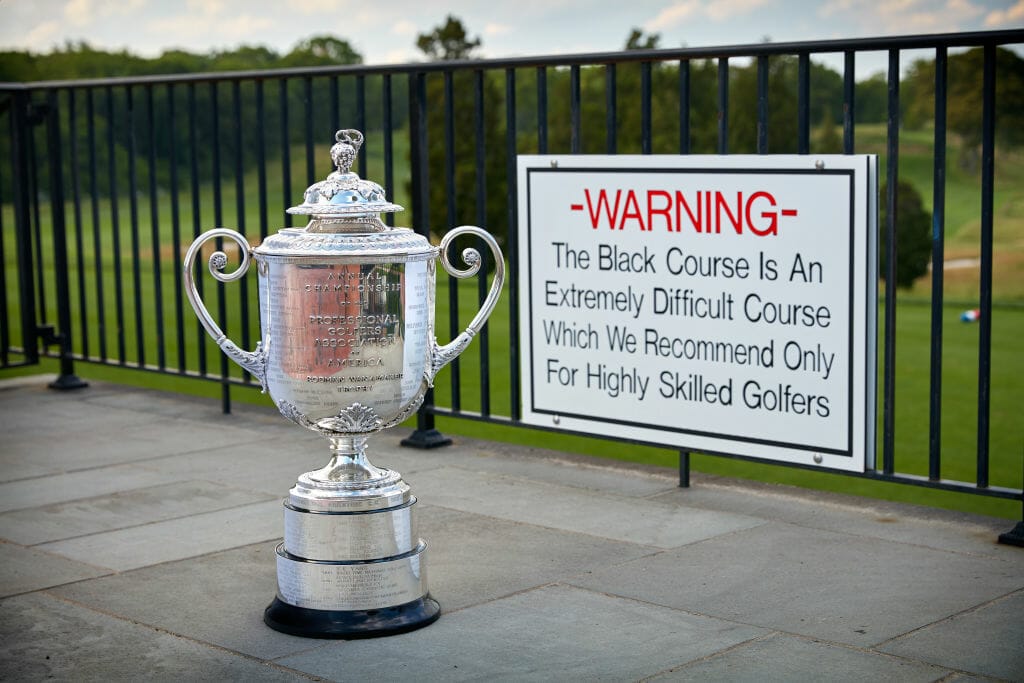Let’s have three cheers for the US PGA Championship, which begins a new chapter in its illustrious history by occupying a new calendar date, starting tomorrow week, May 16, and finishing on Sunday 19th at Bethpage Black in Farmingdale, New York.
Unaccustomed as we are to following The Masters so quickly with a major Championship, this is a bonus for golf fans worldwide, coming as it does so soon after Tiger Woods’ sensational triumph at Augusta last month.
The change of date which evolved partly as a result of golf’s return to the Olympics, can work really well for the PGA Championship and its promoters, the PGA of America.
Traditionally their premier event has, rightly or wrongly, suffered from the perception that because it followed The Masters, US Open and The Open Championship as the final major of the season, it somehow had less of a profile.
How that evolved is hard to say. Ironically, the PGA, first played in October 1916, became established long before the inaugural Masters which began as a fledgling Invitational event in 1934.
The PGA of America, which now numbers 29,000 club and teaching professionals among its ranks, has grown exponentially since being founded 103 years ago.
That said, their premier event bounced around the calendar for a long time, first being played in October ‘16, and having February, March, May, June, July, August, September, October, November and even December dates in its history.
The last time it was played in May was 1949 when Sam Snead beat Johnny Palmer in the final.
Five years later, the PGA slotted in as the final major of the season, and has occupied that position ever since. A significant alteration to format came in 1958 when match play was ditched in favour of 72 holes stroke play, largely at the behest of TV executives who wanted to avoid the uncertainty of the head-to-head contests finishing early.
There are a number of factors that should always ensure total respect for the Championship, not least that it regularly boasts the strongest field based on World Rankings and that it is the only all-professional of the four majors.
The roll of honour stands comparison with the other three majors over the last 100 years. Jack Nicklaus and Walter Hagen hold the winning record, each with five titles. Tiger Woods hoisted the Wanamaker Trophy four times. Rory McIlroy and Ben Hogan are among the two-time PGA champions, and Pádraig Harrington made it the third of his majors by winning at Oakland Hills in 2008.
This one will be big. For a start, Tiger’s Masters win immediately resulted in a surge of requests from the public for tickets. PGA of America CEO Seth Waugh put it in perspective when discussing the change of date to May: “We think we made a great decision, but we’d rather be lucky than good, as well, in terms of what he (Tiger) did in the Masters. We thought it (date change) was smart; it looks brilliant, now. We’re excited,” he said.
Personally, I wonder if Brooks Koepka and Francesco Molinari will similarly describe themselves as “excited” to be playing the first two rounds with Woods, the man who out-thought them and who kept his nerve better than they did on the last day at Augusta.
Technically this has yet to be confirmed, but Kerry Haigh, the Chief Championship officer of the PGA of America said it is very likely that as the winners of the last three majors, Koepka (2018 PGA); Molinari (2018 Open), and Woods (2019 Masters) will spend the first 36 holes together.
Haigh said: “We did talk about it and are continuing our process of having the last three major champions paired together. So that would be Koepka, Molinari and Tiger Woods. We’re certainly excited for the prospect of that, assuming that is what it ends up being.
I think with the strength of the field, being such a strong field, I would say just about every pairing will be a great pairing.”
Bethpage Black, a course on which Joe Public can play – will pose many challenges for the players as was evident in the two US Opens which have been held there, the first in 2002, and again in 2009.
Tiger was in his pomp when he won in 2002, finishing on seven-under-par 277. The USGA played the Black as a par-71 that year. Only Woods, Phil Mickelson, Jeff Maggert and fourth-placed Sergio Garcia completed the 72 holes below par.
In 2009 the USGA adjusted it to par-70. Rain affected play that year, and a Monday finish was required before Lucas Glover got the job done on -4, 276. Glover was one of only five players to break par.
This time the PGA of America get to set up the course and forewarned is forearmed for wannabe Wanamaker Trophy winners. “
“As we’ve already said, it’s a fantastic golf course,” said Kerry Haigh.
“The fairways are not overly wide or generous, so I think there’s certainly going to be a premium on keeping the ball on the fairway and keeping it straight from the tee, and then obviously good iron play into the greens.
“There are, you know, 76 bunkers and every time I go there, it’s almost eight acres of bunker sand to rake every morning. So to keep out of the bunkers is certainly something you want to do. Otherwise your green-side bunker shots are pretty long bunker shots.”
The slightly better news for the players is that, unlike the USGA which likes to make the US Open a punishing test, the PGA of America takes a broader view.
“Our aim is just to set the golf course up so the best players in the world can show their skills on what is truly a great golf course,” said Haigh.
























Leave a comment